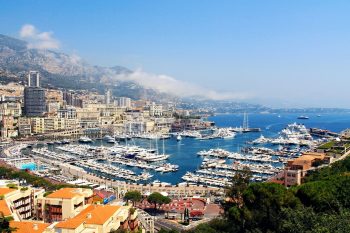A visit to Monaco Posted by Tim Hildreth on May 22, 2018 in Culture, Music, Vocabulary
The Grand Prix de Monaco is this weekend (le 24 – 27 mai/May). It seemed like the occasion idéale (perfect opportunity) to talk about that tiny country nestled between France and Italy along la mer méditerranée (the Mediterranean Sea).

Monaco or Monte-Carlo
At just 2 square kilometers (or 485 acres), Monaco is the second-smallest country in the world (only Vatican City is smaller). The small size doesn’t stop it from being divided up into even smaller parts, or neighborhoods, of which Monte-Carlo, home to the famous Casino, is just one. Other neighborhoods include Fontvieille, which despite its name* is a newer neighborhood built entirely on land reclaimed from the sea, Moneghetti, The Condamine, and Monaco-Ville, which sits above the other parts of the city, and is home to the Prince’s Palace.
Even though Monaco is a separate (and independent) country, the 2015 census indicated that almost a third of the residents of Monaco are French (more even than actual Monegasques!). Until early 2000, it was even possible that Monaco might become French.
Meghan Markle wasn’t the first…
…American actress to marry into royalty.
The Principality of Monaco has been ruled by the same family, the Grimaldis, for over 700 years. Like many modern royals, the current crop of Grimaldis are equal parts celebrity and royal, perhaps not surprising since the current reigning prince, Prince Albert II, and his sisters (Princess Caroline and Princess Stéphanie), are the children of the late Prince Rainier III and American actress Grace Kelly.
Before 2002, if the reigning prince died without a legitimate heir, Monaco would have reverted to French rule. Newer agreements between France and Monaco have changed that… and Monaco has also updated the rules of succession such that the situation of there being no legitimate heir is much less likely.
A day at the races
Run since 1950, the Grand Prix de Monaco is considered by many to be one of – if not the – world’s premier Formule 1 race. Topping speeds over 160 km (100 mph), drivers must complete 78 laps on a 3+km course (circuit in French) that runs right through the streets of Monaco!
While much of the language of Formula 1 comes from English, the following vocabulary (and rules) might help you if you should decide to watch this year’s race.
| Français | English | Indicates... |
|---|---|---|
| Drapeau blanc | White flag | ...a slow car on the course. |
| Drapeau jaune | Yellow flag | ...a danger ahead. |
| Drapeau vert | Green flag | ...the end of danger. |
| Drapeau rouge | Red flag | ...a pause in the race. |
| Drapeau noir | Black flag | ...disqualification of a driver. |
| Drapeau à damier | Checkered flag | ...the end of the race/the winner. |
Comme un ouragon / Like a hurricane
As I mentioned above, the current Grimaldis have a little celebrity in them. While they’re older now and more settled down, in the 80’s and 90’s they had their share of adventures… Including exploring a ‘career’ in song for Princess Stéphanie!
* Remember that vieille means old in French.
This weeks picture of the port of Monaco is from www.Pexels.com (CC0 license).

Build vocabulary, practice pronunciation, and more with Transparent Language Online. Available anytime, anywhere, on any device.




Comments:
r forbes:
Is pilote the French for driver?
Tim Hildreth:
@r forbes ‘Pilote’ (n. masc) can indeed mean ‘driver’, esp. in the case of ‘un pilote de course’ (a race car driver). Like the English word ‘pilot’ it also means “airplane pilot” (‘pilote d’avion’) and can refer to a new or test project.